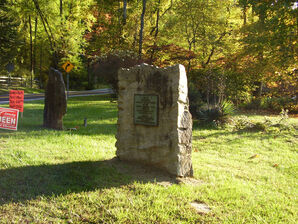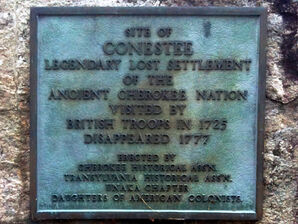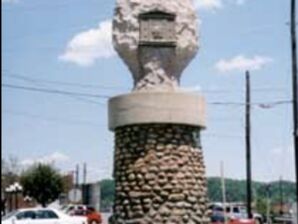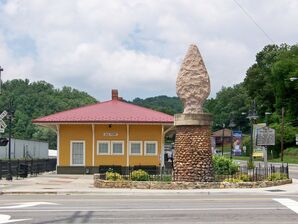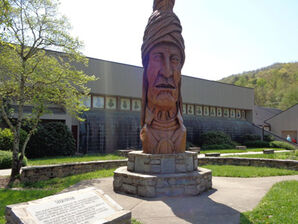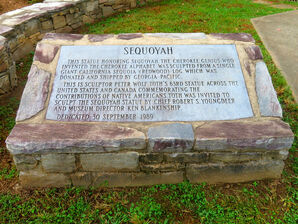How Different Factors Affect Viewers' Interpretations of Native Americans Through Monuments
Introduction
Researchers have found that, "In North Carolina, 184,000 individuals or 1.9% of the state's total population identified as American Indian or Alaska Native, alone or in combination, on the 2010 census. With the exception of Texas, North Carolina's American Indian and Alaska Native population is larger than that of any other southern state (Tippett, 2020)." Most people or scholars assume memorials to Native Americans in North Carolina reflect the detailed history of the distinct tribes and figures. However, these monuments alone are not effective because most Americans lack the necessary knowledge to understand the complexities of being a Native American during colonial times. Over four hundred years ago, there were more than thirty Native American tribes living in present-day North Carolina. Currently, there are eight Native American tribes officially recognized by the State of North Carolina and the Eastern Band of Cherokee Indians is the only North Carolina tribe officially recognized by the federal government (Richardson, 2005). These memorials are effective at displaying the general oppression and hardship these Native American groups suffered as a collective, but the design, placement, and assumptions about the subjects do not justly convey the accomplishments, bravery, and unique history related to specific tribes. This exhibit will show how most monuments fall under this category and an example of what makes an effective monument.
The Conestee Lost Settlement of the Cherokee Tribe Marker
Visually, the stone monument resembles a tombstone. This helps add a sense of respect and grief, but by not including a more emotional aspect it is overall stoic and not specific to Native Americans, let alone to a specific tribe.
Most people would not know the additional history. Cherokee legend says these people were invited to a secret, flourishing village located within the mountains, and they alone of all the Cherokee Nation escaped the long wars and suffering that followed the settlers' invasion of the mountains. The plaque does not provide a further backstory, which would not show how this tribe coped with loss but also help to intrigue viewers. Encouraging people to learn about Native American history should be an important aspect of these memorials since American education includes very little. For example, a database published in 2013 by the National Congress of Indians found that there are currently more than 2,000 U.S. schools with mascots that reference Native American culture (Anti-Defamation & Mascots, n.d.). However, another survey found that "among Native Americans who frequently engage in tribal or cultural practices, 67% find the Redskins team name offensive; 70% find sports fans wearing chief headdresses offensive; 65% find sports fans chanting the tomahawk chop offensive; and 73% find sports fans imitating Native American dances offensive (Wadley, 2020)."
This story could become popular in today’s culture. The well known Lost Colony of Roanoke shares many similarities to this legend. A whole colony disappeared and the modern viewer can easily sympathize with the pain of an inexplicable conclusion surrounding lost. The colony's fate was most likely tragic, but their tribal members chose to immortalize them. It is particularly saddening when one learns the Cherokee tribe view this loss as a blessing because the colony was spared the hardship the remaining tribe members went through. Overall, this monument is ineffective because there is a lack of visual elements and an incomplete history.
Old Fort Arrowhead
Originally the monument was dedicated to the pioneers who founded Old Fort in North Carolina, but now represents the peace between the English settlers and the Catawba and Cherokee Native American tribes. It has a few elements that contribute to making an effective memorial but is missing the visual and historical elements that are needed for the location.
There is not an emphasis that the alliance was not simply between English settlers and Native Americans but includes three groups: Old Fort founders, Catawba tribe, and Cherokee tribe. Native Americans have a complex history that did not start once English settlers arrived. In the U.S., many understand the alliance between the U.S. and Soviet Union during World War II who were forced to work together to stop Hitler’s rule. Similarly, Native American tribes were forced to put aside disputes to fight back against English settlers. This monument does not describe or lead the viewer to contemplate the different dimensions of Native American history.
It can be argued that the arrowhead is not modern to the Native Americans nor does it effectively represent the unity achieved. Although, the large size helps to convey respect and stands out to people. It would be more beneficial to make the inscriptions eye-level or incorporate the base further in the monument. By depicting faces of the Native Americans and settlers, showing how the land was divided between the groups during the time, or sculpt what was traded between groups would have additionally highlighted the importance of the spot.
The setting of this monument is important to note as being located in a public setting can help raise awareness. However, the modern setting creates a juxtaposition of trying to honor Native American history while not making the current issues appear outdated or unimportant to society. The Comanche writer Paul Chaat Smith eloquently expressed the complexities of modern Native Americans. "Just as they did in 1491, Native Americans today live in a land that is ancient and modern, diverse, and always changing. They number in the tens of millions and live in the hemisphere’s most remote places and its biggest cities. They fly spacecraft and herd llamas, they write software and grow orchids, fight wars and teach chemistry. They trade stocks from Park Avenue apartments, drive taxis through Lima’s rush hour, and sell shoes in Kentucky strip malls. Modern American Indians are not shadows of their ancestors, but their equals." It is important to show Native Americans in a way that does not diminish the current issues the community faces with poverty, joblessness, and health, education, and income while not detracting from the inspiring stories of both ancestors of and modern Native Americans.
Whispering Giant
The sculptor says the statue is influenced by a combination of various Native Americans and represents the "cry of the red man," which means the protest of the Native Americans. Officially, it honors Sequoyah, the creator of the Cherokee alphabet. It is a good example of how a monument is able to allow the audience to appropriately reflect on the pain of being a Native American while including details specific to a tribe to show the complex identity of Native Americans.
The face effectively conveys grief through the tears, which also represent the Trail of Tears. Additionally, the subject matter is automatically humanized. Constructing a bust of the figure, allows Sequoyah to be historically accurate with his attire while still being modern since the focus is on the timeless emotion of the face. For instance, if he was shown with a bow and arrow or riding a horse, the modern viewer might be distracted by society's advancements.
The large size creates sense of power and might intrigue the viewer the learn why this figure has gained respect.
The surrounding area allows the viewer to examine and appreciate the monument from different angles and places the audience in the natural environment where the Native Americans once lived. The monument is located outside the Museum of the Cherokee Indian.
In addition to the descriptive plaque, the viewer will have a chance to learn more about the specific tribe’s history in the museum. The Museum of the Cherokee Indian is one of the most modern facilities of its kind in the United States and houses a great collection of Cherokee artifacts. "Here the Cherokee community presents its perspective on its own history and culture. Cherokee people were involved in creating the exhibit: elders, as well as scholars, consulted on the script; life-size figures were created from full-body casts of local people, and many of the voices in the audio portions of the exhibit come from tribal members. The award-winning exhibit combines artifacts with interactive technology, special effects, and colorful graphics (Museum Of The Cherokee Indian, n.d.)." This creation perfectly allows the viewer to learn about the rich history of specific Native Americans while seeing the current issues in a modern setting.
Works Cited
Ncai.org. n.d. Anti-Defamation & Mascots. [online] Available at: <http://www.ncai.org/policy-issues/community-and-culture/anti-defamation-...
Cob, D. and Smith, P., 2017. Modern Day Native Americans: A Story Of Survival And Sovereignty. [online] The Great Courses Daily. Available at: <https://www.thegreatcoursesdaily.com/modern-day-native-americans/>
Romanticasheville.com. n.d. Museum Of The Cherokee Indian. [online] Available at: <https://www.romanticasheville.com/museum_cherokee_indian.htm>
Richardson, G., 2005. American Indian Tribes In North Carolina. [online] Ncpedia.org. Available at: <https://www.ncpedia.org/tribes#:~:text=The%20number%20is%20more%20than,C...(Sampson%20and%20Harnett%20counties)>
Tippett, R., 2020. North Carolina’S American Indian And Alaska Native Population. [online] Carolina Demography. Available at: <https://www.ncdemography.org/2014/11/17/north-carolinas-american-indian-...
Wadley, J., 2020. Study Shows Much Opposition To Native American Mascots, Names. [online] Record.umich.edu. Available at: <https://record.umich.edu/articles/study-opposition-high-to-native-americ...

